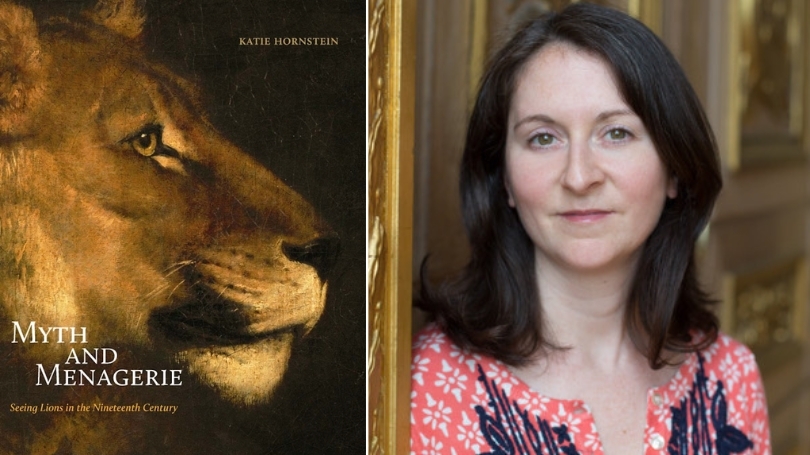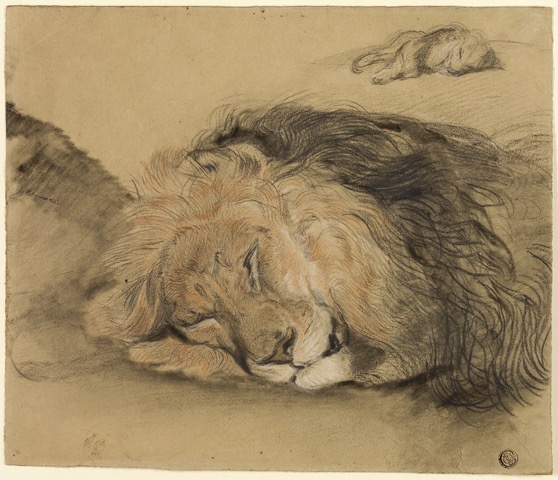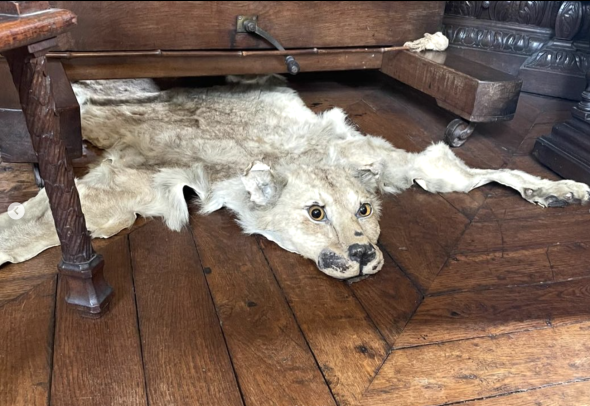

In her new book, professor Katie Hornstein chronicles the lions who populate 19th-century art—and their resulting demise.
In 1838 and 1839, 5,448 lions, hyenas, and panthers were captured in Algeria by the French military and exported to France, Associate Professor of Art History Katie Hornstein reports in her new book. In 1840, the number rose to nearly 8,000.
Hornstein's discovery in 2015 of this detailed accounting of looted wildlife, in an obscure document by the French Ministry of War, led her to the boundary-pushing research project that would follow her first book, Picturing War in France, 1792–1856.
"'France' is not just a country, but a set of geopolitical relationships and systems of movement, exchange, and economies of desire and imagination that extend beyond actual borders," says Hornstein, chair of the Department of Art History. "I wanted a topic that was even more explicit about this."
Drawing on her interests in the material culture of France's conquest of Algeria and the 19th-century trend of exhibiting things—"sites where people fetishized colonialism by coming into contact with its spoils"—Hornstein set out to understand the historical, cultural, and artistic implications of the stolen creatures.
In vivid prose, Myth and Menagerie: Seeing Lions in the Nineteenth Century chronicles the lions who figure prominently in 19th-century painting, drawing, sculpture, and photography alongside the societal changes that brought these wild animals in close proximity with artists and the public for the first time. Thanks to Hornstein, many of these lions now have life stories and names—such as Constantine, Jemmapes, Marengo, Fleurus, and Coco—and can be seen as sentient, expressive beings who "lived in a particular time and place, not as timeless, passive objects of representation" for esteemed artists.
"These creatures were unwitting participants but have not, until now, figured into any critical accounts" of 19th-century art, Hornstein writes.
In a Q&A, Hornstein discusses her research for the book, the painful personal losses that inspired it, and what lessons the tragedy of the Barbary lion offers for our time.
A chapter of the book details your discovery of the compendium by the French military, beginning in 1837, of all the items they had extracted from Algeria, which you describe as "an important material justification for continuing the brutal campaign." Why did lions in particular catch your attention, and what were the next steps in your research process?
Lions have for so long and in so many different cultures been associated with values such as power and strength, but these are generalized meanings that are staked in the symbolic. There's very little in the way of the presence of actual animals with this sort of thinking about the sets of human values these animals can symbolize; we lose sight of the creatures when we say that "the lion means X."
My encounter with this document was the first time I realized that there was something worthy of my attention in the topic of living animals and their relationship to French imperialism. In this otherwise dispassionate list of the stuff expropriated from Algeria in the name of enriching France, here was a very specific instance of actual living animals being part of that process. I was interested!
I started digging into newspaper sources from the 1830s to see if I could find accounts of some of the individual lions encompassed by these otherwise dry government statistics. I found so many writers describing the arrival of lions at the state menagerie; these were creatures donated by French military officers (who were in Algeria waging a brutal campaign of imperial aggression). When these men were not waging war, they hunted for lions and lived out fantasies of domination through the lion hunt. (It must also be said that it was largely through representations that lion hunting was understood to be a classic form of displaying one's power). French military officers would kill the adult lions and send the cubs back to France. That's how the state menagerie of the Museum of Natural History in Paris came to have so many lions during the 1830s and 1840s. I also open the book with an account of the French military plundering 14 lions from the menagerie of the day of Algiers.

I soon recognized that there were lions all over 19th-century art and that this corresponded to new opportunities for the artists to view these animals in real life. This was made possible because of the movement of these animals across the Mediterranean and because of new modes of viewing living animals, such as the first state zoo, which opened in Paris at the same historical moment when you have the very first public museum opening in the present-day Louvre Museum during the French Revolution. I began to connect the dots between these different institutions where regular people (and artists) could view art and animals. I realized that I needed to write about this problem and a book was born!
The book brings together traditional paintings and sculptures by revered artists such as Eugène Delacroix, Théodore Géricault, and Édouard Manet with under-the-radar materials such as zoo guidebooks and hunting manuals. Why was it important to broaden the scope of media for this project?
This is something that I do in all of my work; it just makes sense to me that "art" did not exist in a vacuum and was not produced and understood apart from other kinds of visual and textual materials. I am suspicious of "great artist" art history, which often attempts to carve out a special, hallowed place for artists and their rarified products. I tend to think that less illustrious materials that were more commercially oriented are just as important for our understanding of the "visual economy" of the 19th century.
I'm interested in how objects and ideas circulated; "art"—or as I say in my classes, "art with a capital A"— was one of the ways, but so too were more accessible and "lowly" materials that were not the products of artistic ideation. So yes, it was important that the works of illustrious artists be put into conversation with other materials that represented lions in different ways.
You narrate the lives of lions in captivity who were imported to France, with moving descriptions of their living arrangements and bonds with animals and caretakers. As a self-described "cat person," did any leonine story particularly move or surprise you over the course of your research?
There were far too many that caught my attention! If anything, I had to cut some of them out. The pathetic story of France's first celebrity lion hunter and the young lion he captured in Algeria named Hubert is a standout. Rosa Bonheur's complex relationship to her lioness, Fatma, also strikes me as a standout.
Fatma was one of two cubs gifted in 1885 to the artist by her friend, François Bidel, who was France's most famous lion tamer at the time. I write about their relationship in the book and describe the extent to which Bonheur's pictures of wild animals depended on cosmopolitan practices of captivity like circuses.

I recently went to Rosa Bonheur's estate, which is located outside of Paris, and I saw what happened to the lioness, who lived at the estate. (I describe the visit my book's Instagram.) Fatma was turned into a pelt and was in Bonheur's studio until the artist's death. When you get to know animals in the archives and then meet their material remains, it is always a moving experience.
The book is dedicated to your late cat, Myszka, and your mom, an "ardent cat person." It feels very personal, especially for an art history book, in its attentiveness to individual animals, fusing of art history with animal history, and hints of memoir. What led you to take this nontraditional approach?
This was the first time that I've ever attempted to write in the first person and the book is very, very personal. I decided to allow myself the space to be more creative with art history as well. I felt like I had to do it. I really had no choice. When I say that I wrote the book out of love in the afterword, I really mean it. Grief is what sustained this book and gives it the character that it has; I realized as I was writing through the loss of my mother and my cat in the fall of 2020 and the winter of 2021, that I was also grieving the deaths of the historical lions who are the focus of my book and whose lives and images I have studied.
It was a complex psychological process that I think helped me with my own grieving process and made me more attentive as a writer to the deaths I was writing about. In this sense, art and life really did come together in a way that helped the project and helped me process these losses. I think this comes out in the book. I'm just sorry my mother is not around to see it. But I think she would have found it very cheeky that I dedicated the book to Myszka and to her in that order. She was my biggest supporter, and I miss her every day.
The book closes with the advent of photography and the historical convergence between the increasing circulation of images of lions and their eradication in the wild. The book, you conclude, offers an "image archive that helps tell the story of desire, plunder, proximity, and man-made ecological disaster." What lessons does the tragedy of the Barbary lion offer for our time?
I am interested in this depressing paradox because it tells us a lot about the destruction that can come with the human desire to be closer to wildlife. As we know, the desire for "knowledge" is never entirely benign; there is often a cost. The book was also a way to address issues around the perceived disposability of animal life in our time and the destructive drive of humanity in general.
My editor asked me at one point if there was any way to make my conclusion "less depressing." I explained that there was no way to do that, because this story is inherently depressing. In many ways, the book is premised on the classic story about the problem of "progress" that gets told in the 19th century. It always depends on who is telling the story and who benefits from the idea of "progress." With this book, I was interested in the ways that this logic portended disaster for creatures who have always been admired and feared.
Habitat destruction and extinction are of course not standalone problems that only impact animals; there are lessons here about the greater cost and consequences of 19th-century imperialism that we are still living with today. The Barbary lion is but one episode in a long, tragic history of dispossession that affected all forms of life in the 19th century.